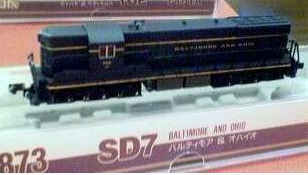

Introduced: 1996
During the 1990s, Life-Like released a whole series of nice looking, good running and (most importantly) affordably priced diesel models (the "plastic chassis" line, if one were to assign them a name). This SD7/9 was pretty much the last all-new model in the series (what with the later E7, E6 and PA models all recycling a version of the older E8 chassis/mech). This model (along with the rest of Life-Like's "wallet-friendly" diesel line) would all be phased out in the early 2000's as Life-Like began concentrating on higher end offerings.
As mentioned above, the chasis is all-plastic and fairly minimalistic (with most of the actual heft being provided by the metal fuel tank and the two free-floating weights situated atop the worm gear towers). The motor is a powerful skew-wound 5-poler with dual flywheels. The driveshafts are mostly metal, with a piece of plastic tubing in the center. Apart from the brass worms, all the gearing is plastic. Eight of the twelve wheels are geared (the center axles on each truck being idlers). All twelve wheels provide pickup, with current transferred to metal contact strips on the chassis via an iffy quartet of sticky-uppy wipers on the trucks (more on that in a moment). A non-directional headlight is mounted atop the forward weight. Wiring is fairly minimal - apart from the headlight wiring, the only other wire is a short one running from one of the chassis contact strips up to the top motor contact. Couplers are shell-mounted Rapidos (easily converted to MT's). The wheels are blackened and low-profile.
This is a great looking model that has the potential to be an outstanding runner. Unfortunately, those aforementioned "sticky-uppy" contacts that transfer current from the trucks to the chassis are really poorly designed and prone to failure. The basic problem with relying on flimsy / bent contacts is that eventually they're going to get squashed down, lose their bend and ultimately lose contact with the chassis. In fact, a lot of these came from the factory "pre-squished", earning this model a semi-deserved reputation as being a real lemon (which might actually explain why it was the last in the line).
Fortunately, there are a couple of pretty simple solutions to the problem -
#1 - Bend the wipers such that they curve upward all the way to the tip. Do not put a "swoop" or fancy bend of any kind at the tip - simply, let the end point right into the contact plate.
#2 - Solder a Micro-Trains spring to the top-side of each wiper (pointing straight up) at the tip.
Either method should work, allowing the truck wipers to maintain firm contact with the chassis. The end result is consistant "A" level performance (smooth, quiet, good creep speed, reasonable top-end speed, etc) at discount prices.
Trivia - these models have been sold in Moki/MicroAce packaging (presumably not for the North American market) -

More trivia - these models are generally referred to as "SD7/9's" because they can stand in for either prototype (the visible external differences between an EMD SD7 and an SD9 being minimal).
To remove the shell, insert a small screwdriver between the chassis and the shell at the center of each truck to de-clip the shell from the chassis. After all four points are freed, the shell should lift up and off en masse. Don't try pulling up on the shell before first freeing the corners, it'll just fall apart into a million different pieces on you.
Grade: C (A after the truck wiper modification)
Reviewed: 6/96 Model Railroader ("The latest addition to Life-Like's selection of N scale diesel motive power is a nicely detailed and good-running model of an EMD SD7. The price is mid-range, but the appearance and performance can satisfy even the most finicky modeler... Life-Like's SD7 follows the same basic design and construction as the firm's earlier diesel models, and it's offered either with or without dynamic brake blisters, depending on the prototype... The model matches all the major dimensions of the prototype. Life-Like has outdone itself with the body details on this model. Particularly impressive is the safety tread on the walkways. The end ladders, even though they're molded in place, are delicate enough to look good when painted a contrasting color... Handrails, the Achilles heel of most N scale diesels, are well done on this model. They're molded in acetal plastic, making them strong and flexible enough to stand up to ordinary handling. Better still, they're the finest N scale handrails I've seen on a ready-to-run plastic diesel. Even the T-section joints where the stanchions meet the handrails are crisp and clearly visible. The paint on our samples was evenly applied and the lettering is sharp... The SD7 runs as well as some of its more expensive competition. All 12 wheels pick up electricity, but only four axles are geared. Performance was smooth and steady, and the model's speed range was impressive right out of the box. The dual brass flywheels, five-pole skew-wound armature motor, and extra weight give this engine a fair amount of tractive effort. It should easily pull 20 freight cars... Life-Like has equaled the quality of its HO Proto 2000 line with this model. The SD7 has the versatility to work yard or transfer service or pull a mainline freight. B&O, B&LE, CB&Q, CMSP&P, EMD, SP, Undec. Price: $50")